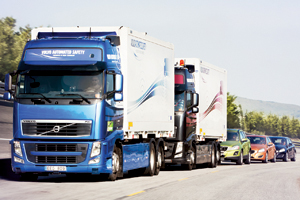First Truck Platoons in United States Only a Few Years Away, Volvo Says

This story appears in the May 25 print edition of Transport Topics.
NEWPORT, R.I. — Advancements in connectivity will bring the first truck platoons to U.S. highways in the near future, paving the way for radical changes in the freight transportation network, executives with Volvo Group said.
Connectivity is “changing the industry and the way we work and the way we communicate,” said Göran Nyberg, president of Volvo Trucks in North America.
Platooning, or a road train, is part of the change. It involves a convoy of trucks electronically linked to a lead truck with an active driver.
“How many people question who is running a big aircraft today? It is fully computerized, and a pilot is governing the environment,” Nyberg said. “This is a mental hurdle we need to accept on the road.”
He made the comments during a series of events here and in nearby Providence on May 15-16, where the executives were on hand for the North American stopover of the around-the-globe Volvo Ocean Race.
Nyberg emphasized that 25-year-olds have never known life without the Internet, and whether they are thinking about driving trucks or becoming tomorrow’s fleet executives, their “connectivity expectations are far different,” he said. “We need to reflect on that going forward.”
Everything from buying vehicles to keeping them running will not only be about human-to-human interaction but also “appliances talking to each other to make life easier,” Nyberg said.
Executives cited the Uptime Center that opened last year at the company’s North American headquarters in Greensboro, North Carolina, as an example of how Volvo and sister company Mack Trucks are making inroads in this area.
More than 75,000 trucks are monitored around the clock through the Uptime Center — a central location for the companies’ customer service and parts and service experts — resulting in reductions of 70% in diagnostic time and 22% in repair time.
Volvo and Mack are units of Gothenburg, Sweden-based Volvo AB.
The presentation here of the truck maker’s near-term vision focused on platooning.
“This is going to be the most viable option to come to market sooner,” said Susan Alt, senior vice president of public affairs.
Referencing the high-profile debut of Freightliner’s Inspiration self-driving truck earlier this month, she predicted no one in the audience is going to “see autonomous heavy-duty trucks in our lifetimes.”
Volvo has been testing platooning in Europe since 2009, generally with two trucks and three cars.
Alt called platooning a way to enhance safety and fuel economy with vehicles that currently exist and without additional infrastructure investments.
The short distance between vehicles boosts fuel economy through less wind drag and lessens the workload for other drivers.
Alt said the company is lobbying for passage of legislation in California to ease tailgating regulations for automated vehicles, setting the stage for actual demonstrations, likely limited to two trucks and on stretches of highways with open terrain.
“Once it starts and we get some experience, then I think the market will begin to accept it,” she said.
Nyberg said acceptance of platooning will be earned much in the same way as the I-Shift automated manual transmission — by people seeing the benefits.
To speed the process of platooning, Volvo is “hoping NHTSA gets onboard and puts out federal regulations,” Alt said. “The challenge NHTSA has is trying to balance forcing a technology versus letting technology come to market and then regulating it.”
She said platooning “could be reality in five years,” but in a media briefing later acknowledged many legislative and liability hurdles still need to be sorted out.
In the meantime, Volvo is pushing ahead with its recent investment in Peloton Technology, a Mountain View, California-based company that is developing a platooning system through vehicle-to-vehicle communications, radar-based braking and vehicle control algorithms.
“Peloton has developed technology aligned with our vision of the future of platooning,” Nyberg said when asked about the investment.
Also under development is a predictive cruise system that can conduct a 360-degree scan of surroundings. In a video simulation, a cyclist in a driver’s blind spot was spared because the truck took over emergency control to avoid an accident.
Providing an even longer view of the benefits of platooning was Jason Cotner, Volvo’s chief designer. In a presentation filled with futuristic sketches he described a society where platooning matures into a round-the-clock system and intelligent trailers break off and join on their own.
Dedicated road-train lanes could include space to move passengers, and he suggested a lead truck pilot might require “a more experienced, trained person,” but smarter truck cabs would ease the stress of the job.
Additionally, there would be a person who has “a complete view of the truck from a remote location like military technology that exists today,” Cotner said.

